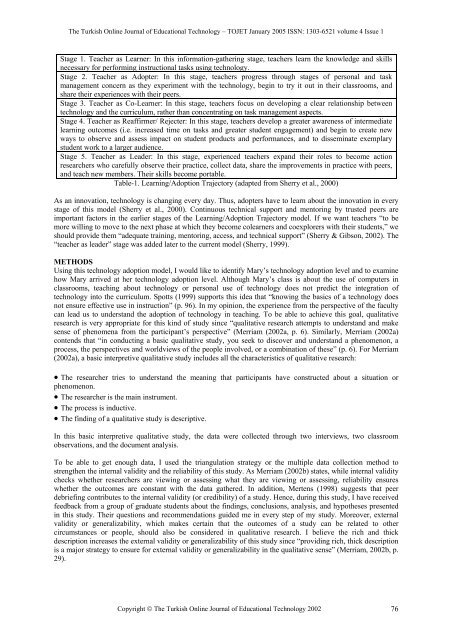Age - TOJET the Turkish online journal of educational technology
Age - TOJET the Turkish online journal of educational technology
Age - TOJET the Turkish online journal of educational technology
Create successful ePaper yourself
Turn your PDF publications into a flip-book with our unique Google optimized e-Paper software.
The <strong>Turkish</strong> Online Journal <strong>of</strong> Educational Technology – <strong>TOJET</strong> January 2005 ISSN: 1303-6521 volume 4 Issue 1<br />
Stage 1. Teacher as Learner: In this information-ga<strong>the</strong>ring stage, teachers learn <strong>the</strong> knowledge and skills<br />
necessary for performing instructional tasks using <strong>technology</strong>.<br />
Stage 2. Teacher as Adopter: In this stage, teachers progress through stages <strong>of</strong> personal and task<br />
management concern as <strong>the</strong>y experiment with <strong>the</strong> <strong>technology</strong>, begin to try it out in <strong>the</strong>ir classrooms, and<br />
share <strong>the</strong>ir experiences with <strong>the</strong>ir peers.<br />
Stage 3. Teacher as Co-Learner: In this stage, teachers focus on developing a clear relationship between<br />
<strong>technology</strong> and <strong>the</strong> curriculum, ra<strong>the</strong>r than concentrating on task management aspects.<br />
Stage 4. Teacher as Reaffirmer/ Rejecter: In this stage, teachers develop a greater awareness <strong>of</strong> intermediate<br />
learning outcomes (i.e. increased time on tasks and greater student engagement) and begin to create new<br />
ways to observe and assess impact on student products and performances, and to disseminate exemplary<br />
student work to a larger audience.<br />
Stage 5. Teacher as Leader: In this stage, experienced teachers expand <strong>the</strong>ir roles to become action<br />
researchers who carefully observe <strong>the</strong>ir practice, collect data, share <strong>the</strong> improvements in practice with peers,<br />
and teach new members. Their skills become portable.<br />
Table-1. Learning/Adoption Trajectory (adapted from Sherry et al., 2000)<br />
As an innovation, <strong>technology</strong> is changing every day. Thus, adopters have to learn about <strong>the</strong> innovation in every<br />
stage <strong>of</strong> this model (Sherry et al., 2000). Continuous technical support and mentoring by trusted peers are<br />
important factors in <strong>the</strong> earlier stages <strong>of</strong> <strong>the</strong> Learning/Adoption Trajectory model. If we want teachers “to be<br />
more willing to move to <strong>the</strong> next phase at which <strong>the</strong>y become colearners and coexplorers with <strong>the</strong>ir students,” we<br />
should provide <strong>the</strong>m “adequate training, mentoring, access, and technical support” (Sherry & Gibson, 2002). The<br />
“teacher as leader” stage was added later to <strong>the</strong> current model (Sherry, 1999).<br />
METHODS<br />
Using this <strong>technology</strong> adoption model, I would like to identify Mary’s <strong>technology</strong> adoption level and to examine<br />
how Mary arrived at her <strong>technology</strong> adoption level. Although Mary’s class is about <strong>the</strong> use <strong>of</strong> computers in<br />
classrooms, teaching about <strong>technology</strong> or personal use <strong>of</strong> <strong>technology</strong> does not predict <strong>the</strong> integration <strong>of</strong><br />
<strong>technology</strong> into <strong>the</strong> curriculum. Spotts (1999) supports this idea that “knowing <strong>the</strong> basics <strong>of</strong> a <strong>technology</strong> does<br />
not ensure effective use in instruction” (p. 96). In my opinion, <strong>the</strong> experience from <strong>the</strong> perspective <strong>of</strong> <strong>the</strong> faculty<br />
can lead us to understand <strong>the</strong> adoption <strong>of</strong> <strong>technology</strong> in teaching. To be able to achieve this goal, qualitative<br />
research is very appropriate for this kind <strong>of</strong> study since “qualitative research attempts to understand and make<br />
sense <strong>of</strong> phenomena from <strong>the</strong> participant’s perspective” (Merriam (2002a, p. 6). Similarly, Merriam (2002a)<br />
contends that “in conducting a basic qualitative study, you seek to discover and understand a phenomenon, a<br />
process, <strong>the</strong> perspectives and worldviews <strong>of</strong> <strong>the</strong> people involved, or a combination <strong>of</strong> <strong>the</strong>se” (p. 6). For Merriam<br />
(2002a), a basic interpretive qualitative study includes all <strong>the</strong> characteristics <strong>of</strong> qualitative research:<br />
• The researcher tries to understand <strong>the</strong> meaning that participants have constructed about a situation or<br />
phenomenon.<br />
• The researcher is <strong>the</strong> main instrument.<br />
• The process is inductive.<br />
• The finding <strong>of</strong> a qualitative study is descriptive.<br />
In this basic interpretive qualitative study, <strong>the</strong> data were collected through two interviews, two classroom<br />
observations, and <strong>the</strong> document analysis.<br />
To be able to get enough data, I used <strong>the</strong> triangulation strategy or <strong>the</strong> multiple data collection method to<br />
streng<strong>the</strong>n <strong>the</strong> internal validity and <strong>the</strong> reliability <strong>of</strong> this study. As Merriam (2002b) states, while internal validity<br />
checks whe<strong>the</strong>r researchers are viewing or assessing what <strong>the</strong>y are viewing or assessing, reliability ensures<br />
whe<strong>the</strong>r <strong>the</strong> outcomes are constant with <strong>the</strong> data ga<strong>the</strong>red. In addition, Mertens (1998) suggests that peer<br />
debriefing contributes to <strong>the</strong> internal validity (or credibility) <strong>of</strong> a study. Hence, during this study, I have received<br />
feedback from a group <strong>of</strong> graduate students about <strong>the</strong> findings, conclusions, analysis, and hypo<strong>the</strong>ses presented<br />
in this study. Their questions and recommendations guided me in every step <strong>of</strong> my study. Moreover, external<br />
validity or generalizability, which makes certain that <strong>the</strong> outcomes <strong>of</strong> a study can be related to o<strong>the</strong>r<br />
circumstances or people, should also be considered in qualitative research. I believe <strong>the</strong> rich and thick<br />
description increases <strong>the</strong> external validity or generalizability <strong>of</strong> this study since “providing rich, thick description<br />
is a major strategy to ensure for external validity or generalizability in <strong>the</strong> qualitative sense” (Merriam, 2002b, p.<br />
29).<br />
Copyright © The <strong>Turkish</strong> Online Journal <strong>of</strong> Educational Technology 2002 76
















